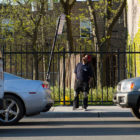Are the billions of dollars being spent in the Chicago region on highway expansion just helping to move jobs further away from the low-income communities that need them?
That’s the argument made recently by Ron Burke, policy director of the Active Transportation Alliance.
The amounts being spent are huge: $3.4 billion total for the six-mile Elgin-O’Hare tollway and a second leg that’s planned from O’Hare Airport to Bartlett; $4 billion for an expansion of the Tri-State Tollway; and a potential $2.65 billion for the controversial extension of Route 53 into Lake County, a project that was shelved and then revived. Then there are the expansions of the Eisenhower and the Stevenson expressways, now being planned by the state.
The costs are basically being covered by user fees: tolls on the tollways–three times the standard rate on the Elgin-O’Hare, and twice that for drivers without transponders; and for the Eisenhower and Stevenson expansions, the idea is to use a public-private partnership that will charge tolls for new express lanes.
That’s a lot of money in a state that’s practically broke, especially if Burke is right that these projects are “a waste of money.” He points to historical evidence that shows that highway expansion doesn’t reduce congestion, and he argues that it undermines alternative modes of transportation that do reduce road congestion.
But it may be a particularly bad investment if these projects are making life harder for residents of low-income communities in Chicago who are seeking work in the region’s manufacturing plants and warehouses. Continuing highway expansion is “facilitating the location of jobs farther away from transit” in a pattern that’s “highly inequitable,” Burke told me.
He points out that five of the six largest employment centers in the region are located in the suburbs, “nowhere near good transit.” In transportation planning circles, he said, “you don’t hear any discussion of equity or discrimination.”
If you build a highway, businesses will locate on it, said Nebiyou Tilahun, a professor in the Department of Urban Planning at the University of Illinois at Chicago. Research shows that “induced development” accounts for a significant portion of new traffic on expanded roadways, he said.
| INVESTIGATION: |
Tilahun directs the Travel Behavior and Urban Systems Research Group, which has designed an online Metropolitan Chicago Accessibility Explorer that shows the level of access to particular employment sectors for Chicago residents. It shows that “if you don’t have a vehicle, it’s very hard [from some Chicago communities] to reach jobs in manufacturing, transportation and warehousing,” where businesses “tend to choose suburban locations that are difficult to reach.” For jobs in professional, technical, and financial sectors, on the other hand, there is “very good access” for Chicagoans.
“Some very low-income areas, particularly on the South Side, have very limited access to any types of jobs,” he said.
The Chicago Reporter detailed last year the travails of low-income workers getting to work in the suburbs, including two-hour commutes each way, very long walks to transit services after business hours, and van services that left workers stranded.
Plenty of studies have documented the scope of this problem. “Regional sprawl” is one of the most significant factors in the “spatial mismatch” between employment opportunities and low-income communities, according to an extensive study of the impact of segregation by the Chicago Urban League last year. Entry-level and low-skill jobs are increasingly concentrated in suburban communities with little or no public transit, the Urban League found, and commutes from racially segregated low-income communities to three major suburban employment hubs with 26 percent of the region’s jobs are “difficult to impossible.”
UIC’s Great Cities Institute has detailed the “continuous downward trend of manufacturing employment” in Chicago, where employment was once spread across the city’s neighborhoods. In 1960, the manufacturing sector employed nearly 30 percent of 20- to 24-year-old African Americans in Chicago; in 2015, it employed less than 3 percent. The impact of “the dramatic departure of jobs from large sections of the city and the rise of chronic and concentrated joblessness” cannot be overstated.
Relatively low-cost options, like rapid bus lanes, could help connect the spokes of the region’s “hub-and-spoke” transportation system, which feeds into downtown Chicago but doesn’t serve workers commuting across the suburbs, Burke said.
Land use issues are central, said Audrey Wennink, transportation director for the Metropolitan Planning Council. She said the council’s 2015 “Grow Chicago” report found that over recent decades, “density is decreasing” in the region. “We’re not going in the right direction in terms of developing businesses and housing around transit, in a way that would increase equity.”
She adds that suburbs need to step up efforts to develop affordable housing. And job creation efforts should also focus on areas of Chicago, particularly the South Side, with large tracts of vacant land near transit and expressways.
But the first step might be to stop spending billions of dollars on highway expansion that drives jobs further away from the people who need them.




These projects are subsidies, pure and simple.
Aren’t all projects using government funds subsidies?
The suburbs are a creation of, and would not exist without trillions of dollars in corporate, and personal welfare, and other subsidies.